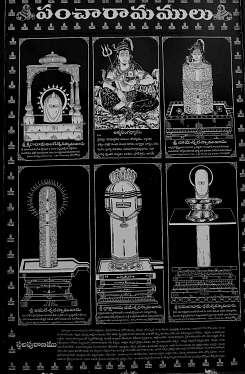The Pancharama Kshetras or the Pancharamas are five ancient Hindu temples of Lord Shiva situated in Andhra Pradesh. The Sivalingas at these  temples are made from a single Sivalinga. As per the legend, this Sivalinga was owned by the Rakshasa King Tarakasura. No one could win over him due to the power of this Sivalinga. In the war between deities and Taraka, Kumara Swamy and Taraka were face to face. Kumara Swamy used his Sakthi aayudha to kíll Taraka. By the power of Sakti aayudha the body of Taraka was torn into pieces. But to the astonishment of Lord Kumara Swamy all the pieces reunited to give rise to Taraka. Kumara Swamy repeatedly broke the body into pieces and it was re-unified again.
temples are made from a single Sivalinga. As per the legend, this Sivalinga was owned by the Rakshasa King Tarakasura. No one could win over him due to the power of this Sivalinga. In the war between deities and Taraka, Kumara Swamy and Taraka were face to face. Kumara Swamy used his Sakthi aayudha to kíll Taraka. By the power of Sakti aayudha the body of Taraka was torn into pieces. But to the astonishment of Lord Kumara Swamy all the pieces reunited to give rise to Taraka. Kumara Swamy repeatedly broke the body into pieces and it was re-unified again.
Lord Kumara Swamy was confused and was in an embarrassed state then Lord Sriman Narayana appeared before him and said “Kumara! Don’t get depressed, without breaking the Shiva lingham worn by the asura you can’t kíll him” you should first break the Shiva lingam into pieces, then only you can kíll Taraka Lord Vishnu also said that after breaking, the shiva lingham also will try to unite. To prevent the Linga from uniting all the pieces should be fixed in the place where they fall by worshipping them and building temples on them.
By taking the word of Lord Vishnu, Lord Kumara Swamy used his Aagneasthra (weapon of fire) to break the Shiva lingham worn by Taraka. The Shiva lingham broke into five pieces and was trying to unite by making Omkara nada (Chanting Om). Then Surya deva by the order of Lord Vishnu fixed those five pieces of Shiva linga and worshipped them by building temples over them. By the formation of temple the pieces stopped their movement and were famous of panchrama kshetras. All the five Shivalinga in these five places have got scaly marking as them which are believed to be formed by the power of Agneyasthra used by Lord Kumara Swamy.
According to legend, these five pieces were installed as Sivalingas at five different temples by Indra, Surya, Chandra, Vishnu and Kumara Swamy at the respective places. These places (or Aaramas) are as follows:
Amararama at Amaravati
Amaravati is present in Guntur district, on the bank of Krishna river. Where as remaining four are present in Godavai districts(two in east godavari and other two in west godavari districts). Bus facility is so good, as all buses will go up to the temple. Amara Lingeswara swami is worshiped by Lord Indra here. The temple is old and in three circles with so many temples with in the compound. Bala Chamundeswari mata is the goddess here. Venu Gopala swami temple is also present with in the campus of main temple.
Draksharama at Draksharamam
This is near Ramachandrapuram. The temple is very big and has three circles as compounds. This is also under control of Archeological department. Lord Shri Rama worshiped Lord Shiva here. Next followed by Lord Surya and Indra. Manikyamaba devi, one of 18 shaktipeethas is present here. Vemulavada Bhima kavi, famous Telugu poet born in Vemulawada in Karapa Mandal, East Godavari, Andhra Pradesh close to Dhraksharamam, got boons from Bhimeswara swami here.
Somarama at Bhimavaram
Someswara swami temple is present in Gunupudi. It is about 3 to 4 km distance from Bus stand. The temple looks as new one, and a holy pond (Chandra-kundam]Chandra Kundam) is present in front of the temple. Lord Chandra get rid of his sins here by worshiping Lord Shiva here. Hence the name Someswara swami. Shiva lingam change its color according to the lunar month (Black at the time of Amavasya, White at the time Pournami). Annapurna mata temple is present in the second floor.
Ksheerarama at Palakollu
Ksheera Rama Lingeswara swamy gave Sudarshana chakra to Lord Vishnu here. Upamanya Maharshi also got boons and milk from Lord Shiva here. Hence the name Ksheera (milk) Ramalingeswara swami. The temple is near to Bus stand. The temple Gopuram is very high and we can see it from bus stand. Parvati is the goddess here.
Kumararama in Samalkota
Kumara Bhimeswara swami temple is present in Samarlkota. It is about 20 km distance from Kakinada and about 1 km distance from Samarlakota Railway station. It is a very old temple under the control of Archeological department. Lord Shiva is in the form of very big Shiva linga, and we can see Shiva linga through second floor. Kumara swami laid down Shiva Linga here, hence the name Kumararamam. Bala Tripura Sundari devi is the goddess here.